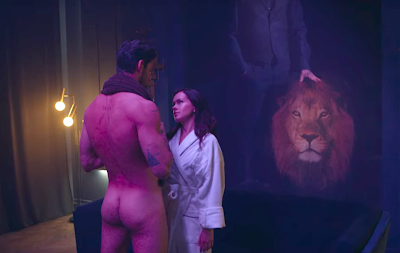The folly of men playing God has been a favorite trope in sci-fi and horror films, as far back as James Whale’s 1931 adaptation of Mary Shelley’s Frankenstein. We probably have more to fear from God’s self-appointed enforcers (Google it; one link won’t do the subject justice), but our suspicions are more easily riled by those geeks in their labs, believing in evolution and telling us to wear masks, possibly because we all harbor memories of them ruining the grading curve in advanced biology back in high school. What other sinister things are the nerds up to, beside wrecking our GPAs and telling us to vaccinate our kids?
Hollywood knows: the scientists are building killer sex monsters!
Of course, that’s never the stated goal. In director Frank Nelson’s 1976 movie EMBRYO (a.k.a. Created to Kill), Dr. Paul Holliston (Rock Hudson) is just trying to save babies. He gets to put his research to the test after he hits a pregnant Doberman pinscher while racing home one rainy night. The mother isn’t likely to survive, but Holliston thinks he can save her puppies, transferring them to his handy artificial womb and injecting them with “Placentolactogen,” the growth hormone he and his late wife were developing before she was killed in a car accident.
 |
| Fetal Puppy Syndrome |
Only one of the pups survives, but it’s enough to convince the doctor he’s made a major breakthrough. What’s more, the puppy grows at an accelerated rate. In mere days, Holliston has a full-grown Doberman—named Number One—that can get its own food out of the refrigerator and put the bowl in the sink when he’s done. Number One can also let himself out of a parked car and kill a stuffed dog barking terrier, but the doctor, inside a hospital convincing a colleague to surrender any spare fetuses he might have lying around, isn’t around to witness his experiment’s sudden violent aggression.
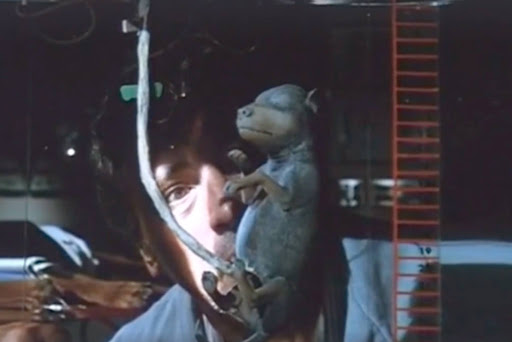 |
| Rock Hudson is astonished that his career has come to this. |
Holliston’s pal at the hospital comes through, donating the fetus of a pregnant woman who committed suicide (hey, she’ll never miss it). The doctor quickly gets to work, pumping the baby so full of Placentolactogen that, in less than five weeks, he has a full-grown Barbara Carrera, who presents herself wearing nothing but her hair, Lady Godiva-style. The softcore Muzak on the soundtrack hammers home the message that she’s now down to fuck. The doctor names her Victoria, because her survival is a victory for both of them.
Like Number One, Victoria is a super-fast learner, going from basic math to reading the entire Bible (“An interesting story, but not very logical”). The doctor takes Victoria’s distinct Latin accent in stride. Were the movie to address this I’m sure it would explain away Victoria’s accent with a reference to her deceased mother being of Latin descent, as if accents are genetic. Instead, we’ll just assume that all humans injected with Placentolactogen sound like they come from Nicaragua.
The doctor, by the way, does not live alone. His sister-in-law Martha (Diane Ladd) stays with him as a housekeeper, and it’s implied she might aspire to take her late sister’s place as Holliston’s second wife. Yet the movie wants us to believe that not once during the weeks that Holliston was experimenting on a fetus, and then a human child, did Martha wonder what he was up to. Did Martha ever hear a baby cry or wonder about the dirty diapers in the laundry? Nope, not one fucking time. There’s one close call, when Martha enters the lab with the adult Victoria hiding behind the door, knife in hand, but otherwise, she is oblivious to her new housemate.
Martha finally meets Victoria weeks later at a party thrown by Holliston’s son Gordon and his pregnant wife Helen (John Elerick and Anne Schedeen, doing her best Brenda Vacarro impression), Holliston introducing her as his new live-in lab assistant. Martha is less than pleased, all but muttering “bitch” under her breath when Victoria walks away. Roddy McDowall, as a snooty chess player (“Chess is one of the last bastions of male chauvinism,” he huffs) whom Victoria almost bests in a game, isn’t a huge fan of Holliston’s “assistant” either. It’s to the movie’s detriment that there is no scene of Roddy and Martha huddling in the kitchen talking shit about Victoria. Everyone else—including Dr. Joyce Brothers in a WTF? cameo—finds Holliston’s hot new assistant absolutely charming.
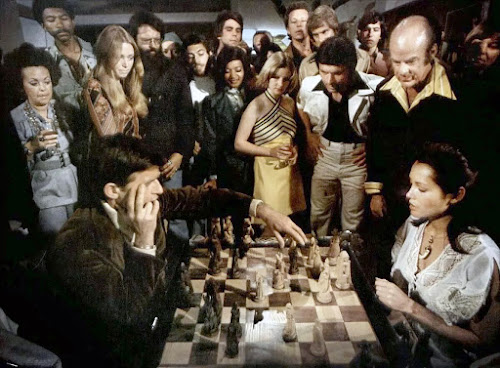 |
| A party in serious need of cocaine. |
 |
| Barbara Carrera is ready to learn. |
After the party, Victoria surprises Holliston in his bedroom, letting him know she wants her experiences with intercourse to extend beyond the social kind. “I want to learn,” she says breathily, her nipples showing plainly through a sheer gown (
Embryo may be rated PG, but it’s a
’70s PG). The popping of Victoria’s cherry is the beginning of the end, however, as one orgasm is all it takes for her to start experiencing some painful side effects. Now she’ll stop at nothing to get the 70ml of “pituitary gland extract” from an unborn fetus she needs to stay young and hot, even if it means endangering the lives of a pregnant hooker and Helen. Basically, she turns into [insert name of celebrity addicted to plastic surgery here] on the eve of his/her 40th birthday.
Embryo is basically a 1970s take on a 1950s mad scientist movie. (
MoriaReviews.com sources an even earlier—and uncredited—inspiration, the 1928 German film
Alraune.) Though he’s phoning it in, Hudson makes the movie watchable, but even his star power can’t keep
Embryo from looking like a made-for-TV movie (only Carrerra’s bare breasts assure us it isn’t). Ladd has been in
worse movies, but she’s wasted here, asked to do little more than look annoyed and serve coffee. Carrera does OK despite being is miscast, though her nude scenes will make more of an impression than her performance.
Penis Slugs and an Exciting Fetish
Nearly 33 years later
Embryo’s plot was revived in 2009’s
SPLICE. (Or, 81 years later
Alraune’s basic plot was again recycled, but I’m henceforth sticking to my
Embryo/Splice comparison. Let’s just accept there’s nothing new under the sun.) Though it is a rehash of an old story, director Vincenzo Natali was allowed to do what so many studios are now afraid to do: avail himself of an R-rating, making a movie reminiscent of the earlier work of fellow Canadian David Cronenberg. Guess it helps to have Guillermo del Toro as an executive producer.
Our protagonists are Clive and Elsa (Adrian Brody and Sarah Polley, respectively), genetic engineers at Nucleic Exchange Research & Development, or NERD (groan-inducing wordplay like that just re-enforces the Cronenberg comparisons). In the opening scene we see the couple, who are also romantic partners, birth something that looks like a cross between a slug and a malformed penis. It’s introduced to a previously birthed, much smaller-but-who’s-judging penis slug, the female. The two penis slugs—named Fred and Ginger—immediately extend long, petal-tipped tongues from their urethra-like mouths, swirling them around each other in such a way that they form a pink flower between them. It’s almost pretty. “They’re imprinting,” says an awestruck Elsa.
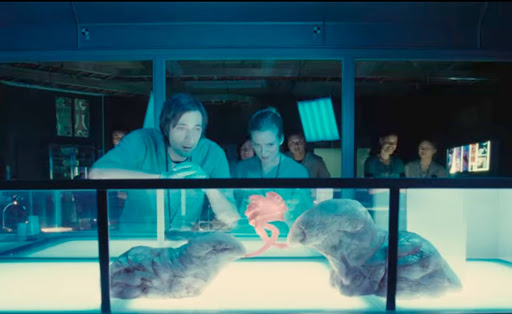 |
| When penis slugs meet. |
Fred and Ginger are the result of splicing DNA from multiple species, and they can be used to produce medicinal proteins. Clive and Elsa are eager to move on to the next phase of their research, incorporating human DNA, but the corporation funding their work—represented by a somewhat sinister Simona Maicanescu—wants to get Fred and Ginger on the market as soon as possible. The lab’s ass-kissing boss, William Barlow (David Hewlett of
Stargate: Atlantis, as well as Natali’s earlier film,
Cube), readily concurs.
Clive and Elsa aren’t so accepting of the decision and immediately head to the lab for an experimentation montage. The end result is something that resembles a sentient testicle, but that’s only the placenta. What bursts out kind of resembles a shaved, earless cat with two digitigrade legs. It’s kind of cute, actually. Like Holliston’s experiment in
Embryo, Clive and Elsa’s “baby” develops rapidly, taking on more humanoid characteristics but still distinctly alien. She looks nothing like Barbara Carrera. They name her Dren, nerd spelled backwards (Natali and his co-screenwriters Antoinette Terry Bryant and Doug Taylor might have reconsidered that name had they
watched Farscape).
 |
| Sarah Polley lures her creation with her tasty, tasty fingers. |
Dren’s existence begins to put a strain on the scientists’ relationship. Earlier they discuss having a baby. Clive wants to start a family; Elsa, who had a miserable childhood, does not. Yet it’s Elsa who is eager to bond with Dren, though she seems to treat her more like a pet than a child (some of her teaching techniques are reminiscent of
Dr. Joan Crawford’s in Trog). Clive, feeling the strain of having to keep Dren secret, wants her out of their lives. He discovers Dren has amphibious lungs when he holds her head under water. “How did you know?” Elsa asks. “You did know, right?” Clive says yes, but his eyes say something else.
 |
| Separated at birth: Delphine Chanéac as Dren; Björk in the video for “Hunter.” |
Because their co-workers at NERD are more curious than Diane Ladd, and because they can’t exactly stick a wig on Dren and introduce her as a new lab assistant (she does sort of look like Björk; Icelanders have tails, right?), the renegade scientists need to get Dren away from the lab. Fortunately, Elsa just happens to own a plot convenience: a farm that she inherited from her mother. It’s at this farm that we begin to see Elsa exhibit behavior that invites more Joan Crawford comparisons. Elsa is a perfectly loving parent when Dren is docile and compliant, but she loses her shit when Dren acts out. Then again, what are we to expect when it’s revealed Elsa’s childhood bedroom was more like a cell in a Turkish prison. Elsa’s was not a happy childhood, and yet she held on to this farm, a place that was a living hell for her, paying the taxes and utility bills instead of putting it up for sale before her mother’s body was cold? This strains credulity more than the creation of Dren...
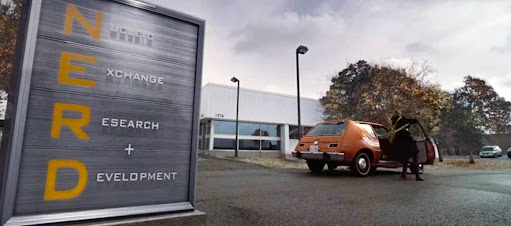 |
| ...or the idea that anyone would choose to drive a Gremlin in the 2000s. |
Clive isn’t exactly Father of the Year. Like Holliston, he crosses some boundaries, but Clive also brings
an exciting fetish into the mainstream [link very NSFW]. There’s also a key tonal difference in how the two movies handle the sex between scientist and, um, subject that makes
Splice a bit more disturbing. Because
Embryo treats the adult Victoria as a sex object from the get-go, the movie and the audience can bypass any pesky questions about the morality of this relationship (not that anyone watching
Embryo is going to think about it that hard). In
Splice, however, Dren, besides being a unique species, is presented as being like Clive and Elsa’s
daughter, adding an extra layer of “eww!” (or “ahh!,” if
that’s your fantasy). Regardless of whether or not you think Clive has committed incest, he’s definitely cheated on Elsa.
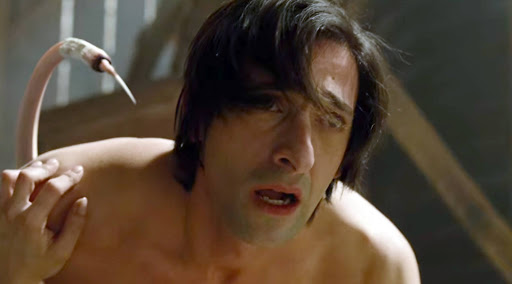 |
| Adrian Brody’s O (I-fucked-up) face. |
Things soon take a more tragic—and rapey—turn in the final act, as the movie abandons psychological nuance in favor of straight-up horror, winding down to a sequel-bait ending—or so it would seem. According to Natali, he just liked the idea of leaving things open-ended; he
never intended for there to be a sequel. (That
Splice under-performed at the box office probably ensured the studio didn’t try to persuade him to change his plans.) With Hollywood being more interested in creating franchises than telling stories, even way back in 2009, I simply forgot that ending movies on a question mark was still a thing.
I had wanted to see
Splice when it first came out, but the film
was released in the U.S. in June 2010, when I, along with much of the
rest of the world, was struggling to stay afloat during a
global recession. Dropping $10 on a matinee ticket just seemed
irresponsible. Thankfully
Splice is currently on
Netflix in the U.S.*, during another economic downturn, no less (this movie just might be cursed). Despite its link to financial catastrofucks,
Splice is still worth checking out, especially if you like your sci-fi
horror to have a few extra I.Q. points, are nostalgic for
Cronenberg’s 1980s horror movies, or just enjoy watching sex scenes featuring
human/animal hybrids. Those who enjoy ’70s schlock can find
Embryo streaming on various sites, with the version on
Tubi being the least shitty looking of the bunch.
*This is a prime sponsorship opportunity, NordVPN. Just sayin’.

















